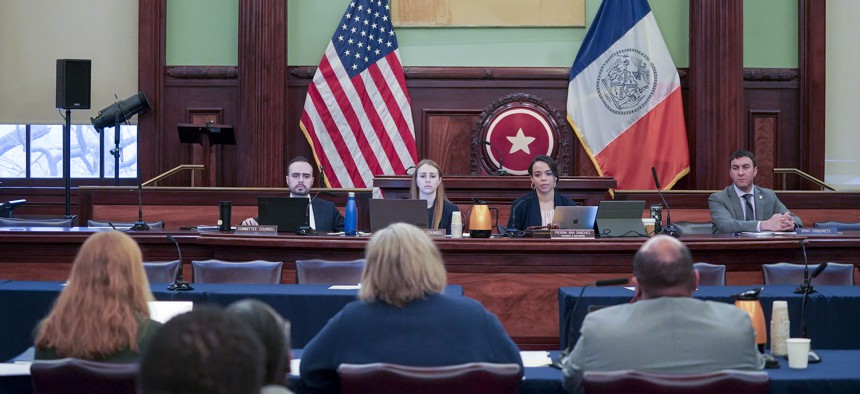Housing
City program to incentivize upgrades to rent stabilized apartments has just one applicant
The pilot program is just one way the city is trying to help get vacant units back on the market, city officials said at a City Council hearing on housing vacancies.

The New York City Council’s Committee on Housing and Buildings hearing on Wednesday. Gerardo Romo / NYC Council Media Unit
Last April, New York City Mayor Eric Adams’ administration announced a pilot program aimed at getting more vacant rent stabilized apartments on the market by giving landlords up to $25,000 to help pay for needed repairs. Landlords would also have to agree to rent those units to people using rental assistance vouchers.
Almost a year later, that program has just one applicant, an official at the Department of Housing Preservation and Development said at a City Council hearing on Wednesday.
“We have not seen a high number of uptake,” HPD First Deputy Commissioner Ahmed Tigani said, when asked about the “Unlocking Doors” pilot program. Tigani said that the pilot is just one of the programs available to help owners of rent stabilized and other units preserve housing. “We knew that this is something that would take time for the owner industry to absorb and ask questions,” he added, noting that the pilot is ongoing.
Wednesday’s council hearing was focused on the 2023 Housing and Vacancy Survey recently released by the city, which found that just 1.4% of all rental housing across the city was vacant and available for rent last year – the lowest vacancy rate since 1968, and a steep drop from a high of 4.5% in 2021. A vacancy rate of less than 5% is needed in order for the City Council to determine that a public emergency for housing is ongoing, allowing rent control and rent stabilization to continue.
The findings of the survey validated just how tough the experience of finding and staying in housing is for the lowest income New Yorkers, said Council Member Pierina Sanchez, who chairs the council’s Committee on Housing and Buildings. Affordable units are even more scarce, with a vacancy rate of less than 1% for units renting for less than $1,650 per month. And while the survey found that the city’s total housing stock increased by about 61,000 since 2021, demand is far outpacing the increase in supply. The survey also found an increase in the number of households earning $100,000 or more since 2021, and a net decrease in the number of households with the lowest incomes.
“New York City continues to see a diverging experience, where low- and middle- income New Yorkers face limited housing choice, while more New Yorkers with more purchasing power continue to grow in numbers,” said HPD Chief Research Officer Elyzabeth Gaumer.
While the survey considers the city’s rental housing stock at large, the hearing drew a particular focus to rent stabilized units, of which there are nearly one million across the city. While those units carry strong protections for tenants including limited rent increases, a significant number of rent stabilized units are vacant but not on the market. The survey found 26,310 such units in 2023, which is a significant decrease from 42,860 in 2021.
Landlords say that they can’t put those lower-cost units on the market because they’re in need of expensive renovations that they can’t afford because their rental income is too low. Tenant and affordable housing advocates have accused landlord groups of deliberately “warehousing” those low-cost units to help fuel their case that rent stabilization doesn’t work and that regulations should be loosened.
But city officials said Wednesday that those vacant rent stabilized units are not available for a variety of reasons, and that only a small portion of the total met the kinds of conditions that would back landlords’ argument that they’re forced to keep them off the market because the rents are too low to recoup the expense of needed repairs. In 2023, 1,700 units were off the market for a year or more, in need of repairs and had a legal rent of less than $1,500 per month, Gaumer said.
The actual size and condition of the city’s stock of vacant, not available rent stabilized units has been debated. The Community Housing Improvement Program, a trade association of landlords of rent stabilized units, argued that the Housing and Vacancy Survey presents an unreliable figure. Adam Roberts, policy director at CHIP, said that the council should look at data that’s based on filings to the city from rent stabilized buildings, rather than a sample of housing stock in the Housing and Vacancy Survey. Roberts pointed to an analysis of rent stabilized apartment registrations by the city’s Independent Budget Office in 2022 that found over 42,000 vacant units, including 13,000 units that were vacant in 2022 and 2021.
The existence of any significant number of vacant rent stabilized units not being put to use is an issue amid a dire housing shortage – one that the city’s Unlocking Doors pilot program aimed to help address. City officials didn’t offer guesses as to why it hasn’t been more popular with landlords at Wednesday’s hearing, but Sanchez said she’s heard feedback from the industry that the grant isn’t large enough. “One thing that I’ve heard multiple times is $25,000 is not enough of a support,” she said.
NEXT STORY: Legislation seeks to ban fast food surge pricing

